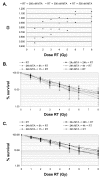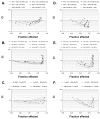In vitro study on the schedule-dependency of the interaction between pemetrexed, gemcitabine and irradiation in non-small cell lung cancer and head and neck cancer cells
- PMID: 20723210
- PMCID: PMC2931492
- DOI: 10.1186/1471-2407-10-441
In vitro study on the schedule-dependency of the interaction between pemetrexed, gemcitabine and irradiation in non-small cell lung cancer and head and neck cancer cells
Abstract
Background: Based on their different mechanisms of action, non-overlapping side effects and radiosensitising potential, combining the antimetabolites pemetrexed (multitargeted antifolate, MTA) and gemcitabine (2',2'-difluorodeoxycytidine, dFdC) with irradiation (RT) seems promising. This in vitro study, for the first time, presents the triple combination of MTA, dFdC and irradiation using various treatment schedules.
Methods: The cytotoxicity, radiosensitising potential and cell cycle effect of MTA were investigated in A549 (NSCLC) and CAL-27 (SCCHN) cells. Using simultaneous or sequential exposure schedules, the cytotoxicity and radiosensitising effect of 24 h MTA combined with 1 h or 24 h dFdC were analysed.
Results: Including a time interval between MTA exposure and irradiation seemed favourable to MTA immediately preceding or following radiotherapy. MTA induced a significant S phase accumulation that persisted for more than 8 h after drug removal. Among different MTA/dFdC combinations tested, the highest synergistic interaction was produced by 24 h MTA followed by 1 h dFdC. Combined with irradiation, this schedule showed a clear radiosensitising effect.
Conclusions: Results from our in vitro model suggest that the sequence 24 h MTA --> 1 h dFdC --> RT is the most rational design and would, after confirmation in an in vivo setting, possibly provide the greatest benefit in the clinic.
Figures




References
-
- Mackey JR, Mani RS, Selner M, Mowles D, Young JD, Belt JA, Crawford CR, Cass CE. Functional nucleoside transporters are required for gemcitabine influx and manifestation of toxicity in cancer cell lines. Cancer Res. 1998;58:4349–4357. - PubMed
-
- Huang P, Chubb S, Hertel LW, Grindey GB, Plunkett W. Action of 2',2'-difluorodeoxycytidine on DNA synthesis. Cancer Res. 1991;51:6110–6117. - PubMed
Publication types
MeSH terms
Substances
LinkOut - more resources
Full Text Sources
Medical

